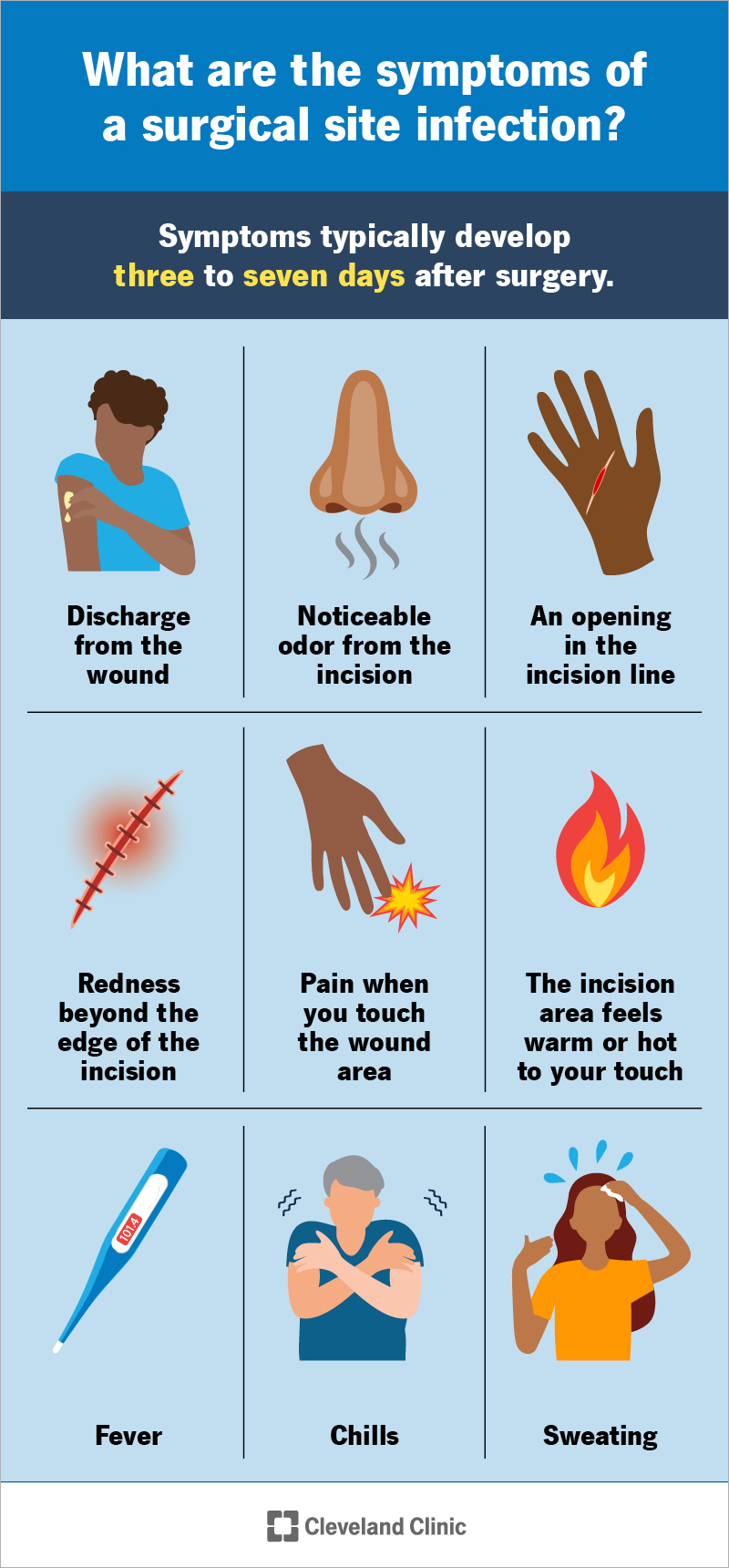Surgery that involves incisions (cuts) in your skin may lead to a surgical wound infection. These infections develop after your surgery. Symptoms are pus draining from the surgery site. The site may be red, painful or feel hot to your touch. Treatment is antibiotics. Washing your hands and making sure others wash theirs is one of the best ways to prevent these infections.
Advertisement
Cleveland Clinic is a non-profit academic medical center. Advertising on our site helps support our mission. We do not endorse non-Cleveland Clinic products or services. Policy

A surgical wound infection (surgery site infection) is an infection that develops after you have surgery. These infections happen when bacteria get into your body through the incisions (cuts) your surgeon makes. They don’t happen often, in part because healthcare providers and hospitals work hard to prevent them. If you’re having surgery, don’t hesitate to ask your surgeon about steps they take to reduce your risk.
Advertisement
Cleveland Clinic is a non-profit academic medical center. Advertising on our site helps support our mission. We do not endorse non-Cleveland Clinic products or services. Policy
The U.S. Centers for Disease Control and Prevention (CDC) lists three types of surgical wound (surgical site) infections:
The U.S. CDC estimates 1 to 3 in 100 people who have surgery develop a surgical site infection.
Symptoms typically develop three to seven days after surgery. Your symptoms may vary depending on the type of surgery that you had. In general, signs of an infection include:
Advertisement
Bacteria cause surgical wound infections. There are millions of different bacteria, but the ones that typically cause surgical wound infection are:
The most common ways bacteria get into surgical wounds and cause infections are:
Your surgeon considers your overall health when they plan your surgery. Several conditions or activities may increase your infection risk:
Healthcare providers also consider your risk of infection by the kind of surgical wound that you have. Surgical wound classifications are:
Advertisement
In general, a surgical wound infection keeps you from recovering from surgery because your wound can’t heal. Other potential complications may include:
Your surgical team will diagnose a suspected infection after surgery. They’ll ask when your symptoms started and if any symptoms got worse over time. To identify the bacteria causing the infection, they’ll take a sample of any pus or liquid seeping from the wound. They may need to remove a few stitches or staples to get a sample.
Antibiotics are the most common treatment for surgical wounds. In some cases, your surgeon may do a procedure to remove the infection.
If you’re like most people, antibiotics will take care of the infection. But you’ll need to continue protecting your surgical wound until it heals so you don’t develop a new infection. Your care team will explain how to take care of the surgery site. But don’t hesitate to ask questions.
Healthcare providers and hospitals constantly work to reduce the risk of surgical wound infections. Providers in the U.S. follow guidelines set by the Centers for Disease Control and Prevention. The World Health Organization sets similar guidelines. Many hospitals have patient safety programs that outline steps providers take to reduce the risk of surgical wound infections. If you’re having surgery, ask your surgeon to explain the steps they’ll take to reduce your risk.
Advertisement
Taking the following steps before your surgery may reduce your risk:
After your surgery, make sure your healthcare providers clean their hands before they examine the surgery site. Protecting you from infection is very important to your providers, and this may be something they always do. But if they don’t, feel free to ask them to clean their hands before they touch you.
The same goes double for visiting friends and family. Everyone should wash their hands with soap and water or an alcohol rub. And they should never touch the wound.
The most important thing is to follow your surgeon’s guidance. If you have a surgical wound infection, they may have specific instructions on how to take care of the wound, so you don’t develop another infection. Here are some other suggestions:
Advertisement
Contact your provider if infection symptoms get worse, even if you’re taking medication, or come back. Keep an eye on your wound for signs of:
Your skin is the first line of defense against infection. It keeps bacteria and germs from entering your body and causing infections. Surgical incisions (cuts) break through that first line of defense. It creates an opportunity for bacteria to sneak into your body, so you develop a surgical wound infection.
Preventing infection is a high priority for all healthcare providers, especially infections that happen after surgery. A surgical wound infection can be a serious medical issue. Preventing surgical wounds is a very important part of protecting your overall health and your body’s ability to heal after surgery. If you’re having surgery, ask your surgeon about the steps they’ll take to reduce your risk.
Sometimes you have surgery planned. Other times, it’s an emergency. No matter how you end up in the OR, Cleveland Clinic’s general surgery team is here for you.

Last reviewed on 06/17/2025.
Learn more about the Health Library and our editorial process.